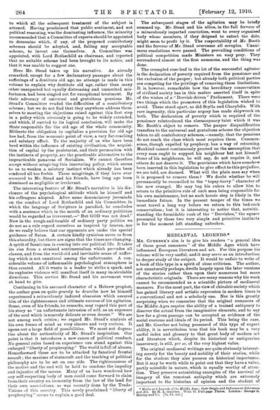MEDIAEVAL LEGENDS.* Mn. GIIEBBER'S aim is to give his readers
" a general idea of those great romances " of the Middle Ages which have influenced European literature and art. For this purpose his volume will be very useful, and it may serve as an introduction to deeper study of the subject. It would be unfair to write of a book of this type in a spirit of close criticism. The author, not unnaturally perhaps, dwells largely upon the later versions of the stories rather than upon their numerous but more characteristic originals. There are many reasons why his work cannot be recommended as a scientific picture of mediaeval manners. For the most part, the view of chivalric society which has gained literary and artistic expression in modern times is a conventional and not a scholarly one. Nor is this greatly surprising when we remember that the original romances of the Middle Ages require the ability of a trained antiquary to dissever the actual from the imaginative elements, and to say how far a given passage can be accepted as evidence of the social customs and ideals of its period. This being the case, and Mr. Guerber not being possessed of this type of expert ability, it is nevertheless true that his book may be a very useful index and glossary to that great body of modern art and literature which, despite its historical or antiquarian inaccuracy, is still, per se, of the very highest value.
The original mediaeval writings are quite obviously interest- ing merely for the beauty and nobility of their stories, while for the student they also possess an historical importance. But it may be worth while to point out that they have a value, partly scientific in nature, which is equally worthy of atten- tion. They preserve astonishing examples of the survival of imagery of the remotest antiquity which are extremely important to the historian of opinion and the student of
• Myths and Legends of the Middle Ages: their Origin and Influence OIL Literature and Art. By H. A. Guerber. With 65 Full-page Plates. London George G. Harrap and Co. [7s. 65. net.] comparative religion. Nor do we allude merely to such cases as the legends of the Wild Huntsman, of Dietrich von Bern, and of the " Questing Beast" in Malory, all of which are possibly reminiscences of the myth of Wodin ; nor to the survival implied in the mediaeval mention of " Wieland the Smith," nor to the still older reminiscences which cling to the magic ring of Fastrada and to that other ring which con- ferred the gift of youth. These are sufficiently interesting, indeed, but they are surpassed by other instances with which we meet in the legends of the Holy Grail. We may find them, for example, even in a book so well known as Malory's La Mort d'Arthur. Mr. Guerber justly calls the legend of the Holy Grail " the most mystical and spiritual " of all mediaeval romances. To Caxton, too, it seemed " a story cronycled for one of the truest and holyest that is in thys world." Moreover, it enshrines one of the most characteristic of the highest Christian ideals current during the Middle Ages. Therefore it is all the more curious to find the story expressed in terms of the most primitive symbolism, recalling—unconsciously though it be—the religions beliefs and the philosophy of immemorial antiquity. Yet such is the fact. Spiritual and Christian as is the motive of the Grail legend, and widely as the intention differs from the primitive intention, the student of comparative religion, in reading Malory's magnum opus, asks himself how such survivals of prehistoric symbolism come to be included in this fifteenth-century work. He reads of the spindles cut out of the tree which grew from the bough plucked by Eve from the tree of life, and he remarks details of the greatest significance. Or again, he will have reason to assimilate to emblems of remotely pre-Christian date even that giver of all good things the Holy Grail itself, and in like manner the sacred spear which is so closely connected with it. Finally, he will not fail to recognise the language, and even the turn of thought, appropriate to the most primitive symbolism in the description of the "sword with the strange girdles." Part of the haft of that wondrous weapon was made of the rib of " the serpent of the feend : and the bone of him is of such vertue, that there is no hand that handleth it shall never be weary or hurt." The scabbard " seemed to be of a serpent's skinne." And again, "the name of the sword is the sword with the strange girdels, and the scabbard, mover of blood; for no man that hath blood in him shall never see the one part of the scabbard which was made of the tree of life." Of all this, of course, Mr. Guerber's book contains no hint. Perhaps enough has been said here to indicate a few facts which the close student learns from the original mediaeval legends. It is of the greatest interest to the historian of human opinion to remark this amazing persistence from primitive time of at least the formulae in which the philosophy of Nature and of man has been expressed.











































 Previous page
Previous page